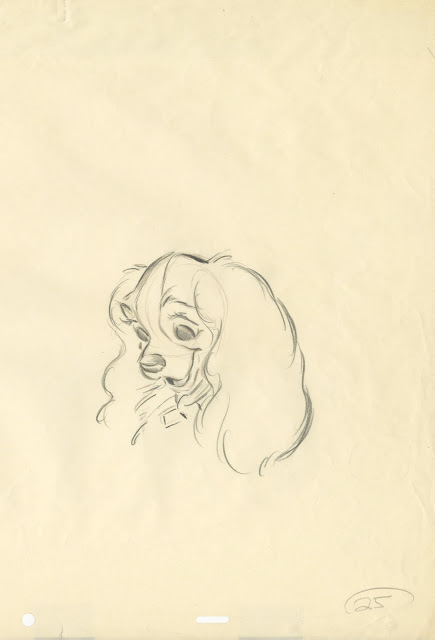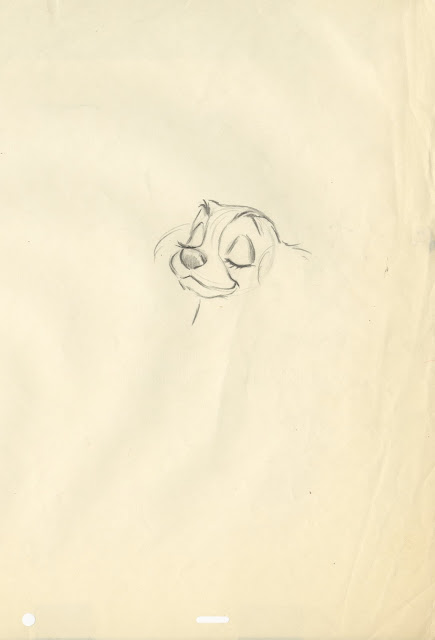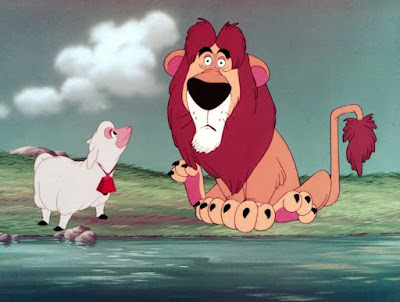Thursday, March 31, 2016
Why this Scene Looks so Amazing
The dog characters in Lady & the Tramp were drawn extremely carefully. The design style called for dimensional realism like the film Bambi, years earlier. This is one of the most iconic scenes in Disney animation, and one of the most beloved. Many of you know that Frank Thomas animated this masterpiece. Two dogs falling in love while eating spaghetti with meatballs. It turned out to be one of those Thomas scenes that shows a kind of life that becomes detached from the animator. These characters live on their own, it seems no artist conceived any of this.
It is interesting to find out that the scene's overall brilliance was the result of teamwork. No question, this is Frank Thomas at his best, but he did get some drawing help from a couple of artists.
Iwao Takamoto had been Milt Kahl's assistant for a number of years, and he was able to absorb some of his boss' master draughtsmanship. On Lady & the Tramp he was put in charge of Lady, making sure that differing drawing styles by a number of animators would be unified in clean up, Iwao was not an animator, but he knew animation principles, and became a perfectionist when it came to bringing a character "on model". He paid insane attention to eyes, eye lids, eye lashes, and the raised volume around eye brows. Iwao's contribution to Lady's appealing look is immeasurable.
He made these drawings over some of Frank's keys as a guide for final clean up. I talked about sculpted drawings before, that's what these are.
Milt Kahl drew a few keys over Frank's roughs such as this one below. Ultimate appeal.
One of Frank's animation roughs for the iconic scene.
Walt Disney very much encouraged this type of team work in order to get superior results.
More about Iwao Takamoto and his work on the following feature Sleeping Beauty
in this post:
http://andreasdeja.blogspot.com/2014/01/iwao-takamoto.html
Wednesday, March 30, 2016
Lost in Translation
Story sketch artist James Bodrero came up with terrific designs for Fantasia's Pastoral sequence.
Particularly the male centaurs with their robust anatomy fit right into the greek mythological settings. Bodrero combined a Clydesdale horse with the upper body of a Greek warrior. These sketches are loose, and parts of the designs are unresolved, therefor not quite ready for animation. But the overall direction in terms of intriguing designs feels right.
By the time final animation models were needed, these centaurs had undergone an unfortunate transformation. Bodrero's solid draughtsmanship is nowhere to be seen. Instead, heavy simplification helped turn these guys into California beach boys (I am quoting from a film critic's observation after the film's release).
The movie's other fantasy creatures, the winged horses, work very well. But the centaurs never reached the design and animation standard they deserved.
Monday, March 28, 2016
Lambert
I really like this charming Disney short from 1952. Bill Peet was the main story artist on Lambert, the Sheepish Lion. Look at this beautiful nighttime scene above. Wether Pecos Bill, Peter Pan, Cinderella or other films, the night scenes always transported me to another world.
If I may be so blunt though, I do not find any "A" type animation in the short. Eric Larson and John Lounsbery are listed among the animators' credits, but no performance really stands out. It's the clever and emotional story that is the real star here.
A few cels featuring the main characters.
An early model sheet, no idea who drew it.
Milt Kahl didn't animate on the film., but he helped out with design and drawing. Here is an example from a previous post:
http://andreasdeja.blogspot.com/2011/06/milt-kahl-ii.html
Friday, March 25, 2016
Tiger Mom Attack
© Andreas Deja
A quick update on my film Mushka.
I just finished animating the sequence when Sarah encounters the tiger cub for the first time.
Obviously the cub's mother nearby isn't too happy about the human contact, she charges.
Above you see one of the key drawings, below is the first rough pass of the same drawing.
In tying down the pose I pushed the right shoulder because the weight is on that leg.
Another section I finished shows Sarah arriving in Siberia on a train, followed by meeting her father for the first time.
So thrilled to see how things are coming together. Also, proud to be able to animate scenes like this one, or shots with human characters without live action reference. I think I am close to 25 % animated.
Prepare to use some Kleenex when you'll see the final film. I still can't tell the film's story without getting teary eyed. This is a very personal project.
© Andreas Deja
Thursday, March 24, 2016
Heinrich Kley and Fantasia
It is no secret that the art of German Illustrator Heinrich Kley had a profound influence on Disney's Fantasia. Before the film went into full production, the head of the character model department, Joe Grant, showed Walt Disney newly published sketchbooks by the German artist. Walt was as exited as Joe about the potential for bringing elephants, alligators and hippos to life inspired by Kley's sensational drawings.
Kley's depiction of anthropomorphic animals is very realistic, yet entirely believable. If elephants could really ice scate or enjoy a day at the beach, it would look like this.
However in preparing models for animation some of the complex realism had to be compromised in order to give animators simplified forms and shapes which could be controlled 24 frames per second.
Disney artists enjoyed this assignment so much, the Dance of the Hours turned out to be one of the best things the studio has ever done - according to Ward Kimball. I couldn't agree more.
This scan of a Kley original from a previous post falls into the Fantasia category:
http://andreasdeja.blogspot.com/2014/03/three-nudes-and-hippo.html
Tuesday, March 22, 2016
Bongo
I have never been a big fan of Disney's film Bongo, which is a part of the 1947 feature film Fun and Fancy Free. (I remember Ward Kimball commenting: "Now, what kind of a title is THAT?")
The first part of the film's story seems ok, a circus bear running away in pursuit of freedom and adventures. But the second part is weird. After being smitten by a female bear called Lulubelle, Bongo runs into a bunch of other bears who show their affection toward each other by smacking the other one's face.
The film's backgrounds are beautiful, I wished I could say the same about the character animation. It is surprising to find out about the credits: Supervising animators were Ward Kimball, Les Clark and Fred Moore. Other names listed under character animation are Art Babbitt and Marc Davis.
I have seen the film several times over the years, and to me the animation looks pedestrian for a Disney product. No scenes stand out as inspired or truly personality defining.
When I was a kid I had a Bongo storybook, and I loved the artwork in it. Still do. Most of the promotional material associated with the film is lovely, it's just that the movie itself falls a bit short.
Sunday, March 20, 2016
More Wizard's Duel Sketches
Here is a sheet with more of Bill Peet's ideas for the Wizard's Duel in The Sword in the Stone.
All drawn on notepad paper outside of the studio during a trip. Peet's mind at work as he searches for entertaining situations provided by all these different animals Merlin and Mim turn into.
My favorite is probably the sketch on the lower right showing Mim as a dragon tripping Merlin as a goat. It didn't make it into the film, but I love the staging.
I wished Peet had not quit Disney during Jungle Book, the picture that followed Sword in the Stone. He was just too valuable to the company...but he was butting heads with Walt, and that was it.
Years later Milt Kahl would leave the studio prematurely as well...these things weren't supposed to happen!
Much more on the Wizard's Duel in this previous post:
http://andreasdeja.blogspot.com/2012/05/wizards-duel.html
Thursday, March 17, 2016
Cinderella Live Action Reference
It's always fun to compare Disney live action photostats with the final result in the film. In this sequence from Cinderella the heroine was supervised by Marc Davis based on performances by Helene Stanley. Milt Kahl was responsible for the Fairy Godmother, whose scenes were played by an unknown actress to me.
Marc made Cinderella lean forward more, so she connects better visually with the business of being measured. Milt changed the way the Fairy Godmother bends down, which looks better graphically.
Helen Stanley's hair and costume is pretty much "on model", while the Fairy's outfit was much simplified for animation.
The following two images are about a couple of frames apart, but the live reference definitely influenced the animator.
Tuesday, March 15, 2016
A Rhino inspires a Dragon
Rocky, the rhino, is a character who was supposed to appear in Disney's Jungle Book. Story man Bill Peet added him to the film's cast, but Walt Disney didn't like Rocky and asked for his removal. Milt Kahl had already produced this terrific model sheet, the rhino was supposed to be voiced by actor Frank Fontaine.
Not all was lost though. Years later when the studio was looking for a new animated dragon, some of Rocky's facial components were borrowed for this new fantasy character, including the hairy ear tips.
Come to think of it, the horn might have worked on the dragon's design as well.
Subscribe to:
Comments (Atom)





















































